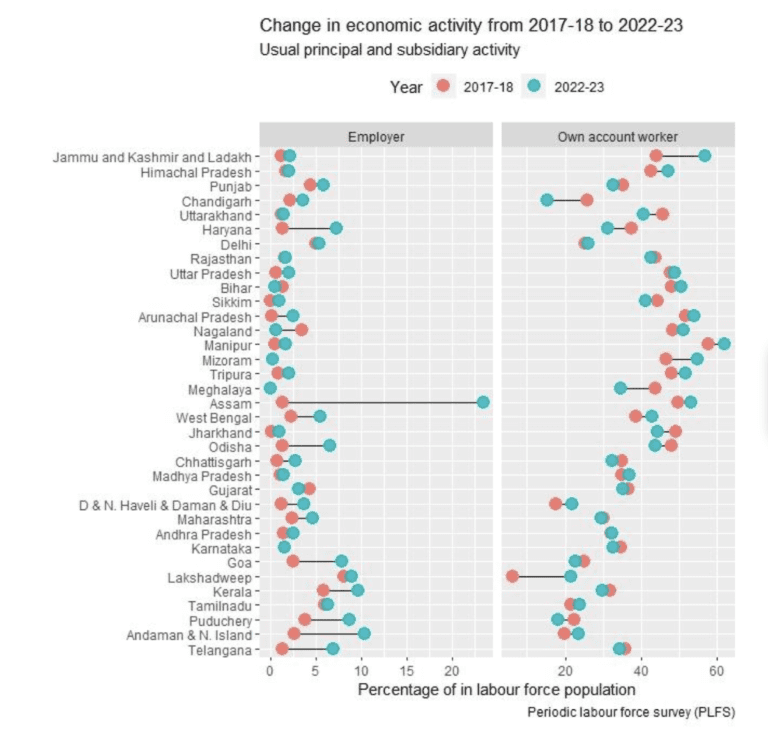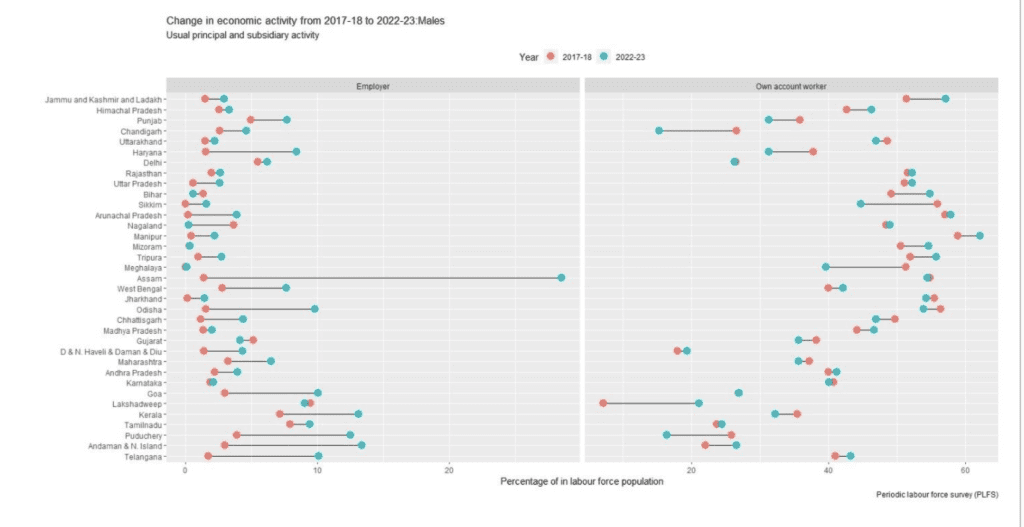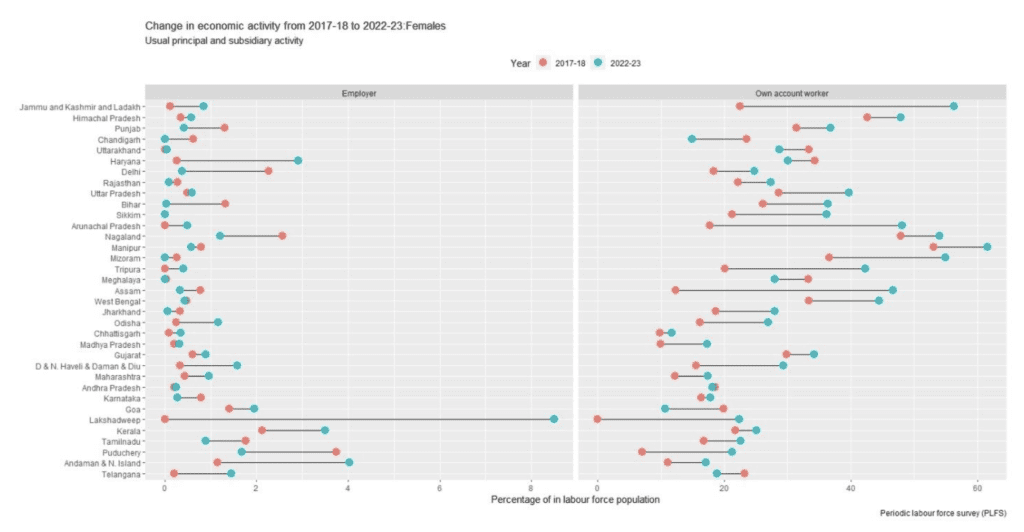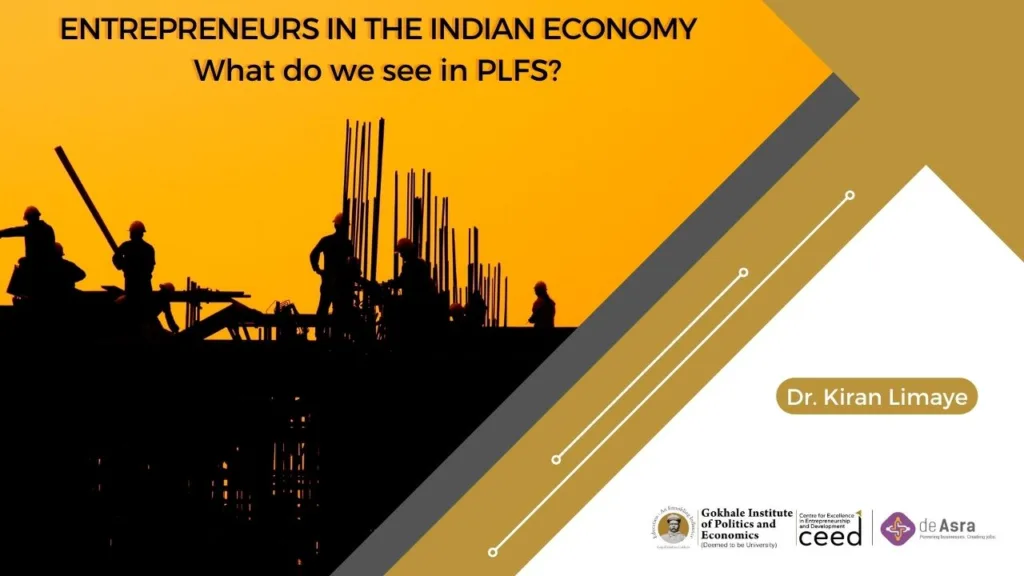In this first article among a series that looks at PLFS to find more about entrepreneurs in India, we will focus on broad contours of change at state and gender levels.
Indian policymakers have launched several programs to kickstart and accelerate entrepreneurship in India. Yet, one is at loss when one tries to gather systematic evidence about Indian entrepreneurs. There is no official and statistically well-founded tracking of entrepreneurship in India yet, no doubt affected by the fact that entrepreneurship is not defined very precisely. As a result, researchers too must turn entrepreneurial to know more about entrepreneurs.
There are several nation-wide, representative surveys which allow us to have a glimpse at entrepreneurs. Economic Census, National Sample Survey (NSS) surveys about enterprises, and Annual Survey of Industries (ASI) allow us to look at enterprises established by entrepreneurs. On the other hand, the Periodic Labour Force Survey (PLFS) allows us to look at entrepreneurs as labour force participants. PLFS provides information on principal and subsidiary economic activity of the person under usual status as well as current weekly status (CWS). Principal activity under usual status is defined in terms of a) economic activity on which a person has spent major time in the 365 days preceding the date of survey. b)Subsidiary status is where a person has spent more than 30 days on economic activity apart from principal activity. c)CWS is based on 7 days preceding the date of survey.
Among the various activities under these statuses, there are two activities which can capture entrepreneurial activity: own account worker and employer in household enterprise. Household enterprises encompass proprietary and partnership ventures. These two activities are under broad classification of ‘self-employed’, which is one of the defining characteristics of entrepreneurs as well. PLFS offers a rich opportunity since it allows us to see patterns in economic status along with geographical, gender, rural-urban, and educational variations.
In this article, we will first look at how these two activities, being an ‘own account worker’ and an ‘employer’, have evolved from 2017-18 to 2022-23. The first ever round of PLFS happened in 2017-18 and a time prior to disruption of Covid-19. 2022-23 is the latest round of PLFS and first year where the economy has largely moved out of Covid-19 disruptions, though some effects on labour force participation might still be lingering.

Between 2017-18 to 2022-23, at a national level, we observe that those who report being an employer have more than doubled and there is an increase of small magnitude in percentage of ‘own account workers.’ (Figure 1) The increase in employers is observed in both rural as well as urban parts, more in rural than urban. But employer percentage for females is nearly stagnant, implying that most of the increase is driven by male employers. On the other hand, there is a large increase in female ‘own account workers’.
Despite a large increase in female ‘own account worker’ proportion, there is not much change at rural or urban level. It indicates that female ‘own account workers’ form a small proportion of account workers and hence change in this small fraction has led to a smaller increase in aggregate. In 2017-18, female own account workers were 12.5% of own account workers in terms of usual status. In 2022-23, this proportion has improved to 23.3%. The disparity is even dire when it comes to entrepreneurs. In 2017-18, females accounted for 6.7% of those who were employers as per usual status. In 2022-23, the proportion has declined to 4.7%, reflecting the stagnant proportion of employers among females.

How is the change at the state level in India? Figure 2 shows that there is considerable variation and anomalous behaviour when we look at the state level picture. When it comes to employers, Assam has recorded highly anomalous growth in percentage of labour force who are employers. Haryana, West Bengal, Odisha, Telangana, and Kerala have shown considerable increase in employer percentage. Otherwise, a broad pattern is we see that the percentage of employers is generally higher as we move from north to south. An opposite trend is evident when it comes to own account workers. The proportion generally decreases as we move from north to south.
Let us focus on two broad trends; increase in percentage of male ‘employers’ and increase in percentage of female ‘own account workers.’ Figure 3 and Figure 4 show change in percentages of ‘employers’ and ‘own account workers’ for males and females respectively.

Since males form a large proportion of employers, the state level pattern of changes is reflected in male employers (Figure 3). This well-anticipated observation highlights skewed reality once again. For females, (Figure 4), states such as Punjab, Delhi, Bihar, and Karnataka have witnessed a fall in percentage of females who are employers. An anomaly here is Lakshadweep, which shows a large increase. Haryana, Odisha, and Kerala show considerable increase in female employers, standing out among other state peers. On the other hand, for ‘own account workers’, we have a broad-based increase in proportion of women who are ‘own account workers’, with some exceptions like Uttarakhand and Andhra Pradesh, which show decrease or no change.

To conclude, PLFS seems to provide a broad corroboration of what many development sector practitioners have been saying for the last few years; that there is an increasing incidence of entrepreneurship, including self-employment, as preferred livelihood choice. The broad evidence needs to be examined in terms of changes in earnings and how it correlates with important aspects of educational attainment, formal as well as technical. We will see that in next articles in the series.
– By Dr. Kiran Limaye






